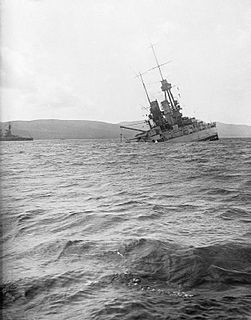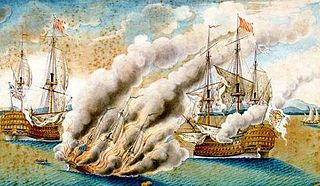This is a list of Royal Navy ship names starting with A.
This is a list of Royal Navy ship names starting with A.

A battleship is a large armored warship with a main battery consisting of large caliber guns. It dominated naval warfare in the late 19th and early 20th centuries.

The battlecruiser was a type of capital ship of the first half of the 20th century. These were similar in displacement, armament and cost to battleships, but differed in form and balance of attributes. Battlecruisers typically had thinner armour and a somewhat lighter main gun battery than contemporary battleships, installed on a longer hull with much higher engine power in order to attain greater speeds. The first battlecruisers were designed in the United Kingdom, as a development of the armoured cruiser, at the same time as the dreadnought succeeded the pre-dreadnought battleship. The goal of the design was to outrun any ship with similar armament, and chase down any ship with lesser armament; they were intended to hunt down slower, older armoured cruisers and destroy them with heavy gunfire while avoiding combat with the more powerful but slower battleships. However, as more and more battlecruisers were built, they were increasingly used alongside the better-protected battleships.

A ship of the line was a type of naval warship constructed during the Age of Sail from the 17th century to the mid-19th century. The ship of the line was designed for the naval tactic known as the line of battle, which depended on the two columns of opposing warships maneuvering to volley fire with the cannons along their broadsides. In conflicts where opposing ships were both able to fire from their broadsides, the opponent with more cannons firing – and therefore more firepower – typically had an advantage. Since these engagements were almost invariably won by the heaviest ships carrying more of the most powerful guns, the natural progression was to build sailing vessels that were the largest and most powerful of their time.
Nine ships of the Royal Navy have borne the name HMS Albion after Albion, an archaic name for Great Britain:

The Home Fleet was a fleet of the Royal Navy that operated from the United Kingdom's territorial waters from 1902 with intervals until 1967.

Pre-dreadnought battleships were sea-going battleships built between the mid- to late- 1880s and 1905, before the launch of HMS Dreadnought in 1906. The pre-dreadnought ships replaced the ironclad battleships of the 1870s and 1880s. Built from steel, protected by case-hardened steel armour, and powered by coal-fired triple-expansion steam engines, pre-dreadnought battleships carried a main battery of very heavy guns in fully-enclosed rotating turrets supported by one or more secondary batteries of lighter weapons.

SMS Westfalen was one of the Nassau-class battleships, the first four dreadnoughts built for the German Imperial Navy. Westfalen was laid down at AG Weser in Bremen on 12 August 1907, launched nearly a year later on 1 July 1908, and commissioned into the High Seas Fleet on 16 November 1909. The ship was equipped with a main battery of twelve 28 cm (11 in) guns in six twin turrets in an unusual hexagonal arrangement.

The 3rd Battle Squadron was a naval squadron of the British Royal Navy consisting of battleships and other vessels, active from at least 1914 to 1945. The 3rd Battle Squadron was initially part of the Royal Navy's Home Fleet. During the First World War, the Home Fleet was renamed the Grand Fleet. During the Second World War, the squadron covered Atlantic convoys.

Shortly after the end of the First World War, the German kaiserliche marine fleet was scuttled by its sailors while held off the harbor of the British Royal Navy base at Scapa Flow, in the Orkney Islands of Scotland. The High Seas Fleet was interned there under the terms of the Armistice whilst negotiations took place over the fate of the ships. Fearing that either the British would seize the ships unilaterally or the German government at the time might reject the Treaty of Versailles and resume the war effort, Admiral Ludwig von Reuter decided to scuttle the fleet.

HMS Actaeon was a 28-gun Coventry-class sixth-rate frigate of the Royal Navy. Her crewing complement was 200 and, when fully equipped, she was armed with 24 nine-pounder cannons, supported by four three-pounders and twelve 1⁄2-pounder swivel guns.

HMS Anne Galley was an 8-gun fire ship of the Royal Navy, launched in 1739 and in active service during the War of the Austrian Succession against Spain and France. Employed against the Spanish Fleet in 1744 off Toulon, she was destroyed while engaging the Spanish flagship Real Felipe.